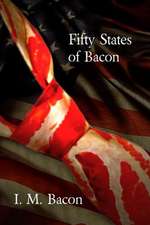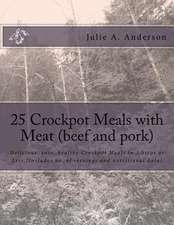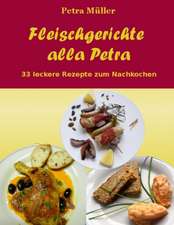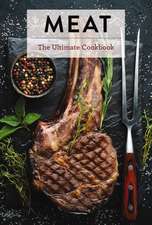MEAT: Everything You Need to Know
Autor Pat LaFrieda, Carolynn Carreñoen Limba Engleză Hardback – 10 sep 2014
Vezi toate premiile Carte premiată
IACP Crystal Whisk Award (2015)
Through heart-warming reminiscences and personal memories, you'll learn of the history of the LaFrieda family's great American success story and how they created a business that's lasted over one hundred years, becoming a New York City landmark along the way. The city even named a street after them in the meatpacking district, Pat LaFrieda Lane.
Dubbed by New York magazine as the King of Meat, Pat Jr. is the mastermind behind the celebrated burgers at many famous restaurants, and he has created over one hundred custom hamburger blends. Now, Pat will reveal to everyone how to create the perfect burger with his all-time favourite burger blend recipes.
Bringing together three generations of experience and exuberant passion for good, satisfying food, this lavishly illustrated and beautifully designed book is sure to be a staple in countless home kitchens for years to come.
Preț: 182.85 lei
Nou
Puncte Express: 274
Preț estimativ în valută:
34.99€ • 36.53$ • 28.96£
34.99€ • 36.53$ • 28.96£
Carte disponibilă
Livrare economică 14-28 martie
Livrare express 28 februarie-06 martie pentru 82.92 lei
Preluare comenzi: 021 569.72.76
Specificații
ISBN-13: 9781476725994
ISBN-10: 1476725993
Pagini: 256
Ilustrații: 50-75 4-C photos throughout; 4-C endpapers
Dimensiuni: 235 x 276 x 33 mm
Greutate: 1.66 kg
Editura: ATRIA
Colecția Atria Books
Locul publicării:United States
ISBN-10: 1476725993
Pagini: 256
Ilustrații: 50-75 4-C photos throughout; 4-C endpapers
Dimensiuni: 235 x 276 x 33 mm
Greutate: 1.66 kg
Editura: ATRIA
Colecția Atria Books
Locul publicării:United States
Notă biografică
Pat LaFrieda’s first introduction to the meat world was in the summer of 1981, when he was just ten years old and learning the tricks of the trade at his father’s butchering business. Thirty years later, Pat, his father, and cousin own and operate New York City’s most prestigious and valued meatpacking facility. Pat LaFrieda Meat Purveyors supplies the finest restaurants in New York City, Philadelphia, DC, Las Vegas, Miami, Chicago, and more. They also operate four retail locations at Citi Field—home to the New York Mets—including two Pat LaFrieda Original Steak Sandwich stands, a LaFrieda Meatball Slider stand, and the sit-down restaurant, Pat LaFrieda Chop House. In 2014 they became the "Official Burger of the Mets." Pat has appeared on countless national TV shows including Today, The Chew, Rachael Ray Show, CNN, Anthony Bourdain: No Reservations, and Martha Stewart. More information can be found at www.lafrieda.com.
Carolynn Carreño is a James Beard Award–winning writer for magazines including Bon Appétit, Saveur, the Los Angeles Times, Gourmet, and Food & Wine, and coauthor of books with chefs Nancy Silverton, Kenny Shopsin, and Sara Foster. Her cookbooks are known for their distinct voice and storytelling style.
Carolynn Carreño is a James Beard Award–winning writer for magazines including Bon Appétit, Saveur, the Los Angeles Times, Gourmet, and Food & Wine, and coauthor of books with chefs Nancy Silverton, Kenny Shopsin, and Sara Foster. Her cookbooks are known for their distinct voice and storytelling style.
Extras
Meat
When I came to work with my father in 1994, he had just started selling to Il Mulino, an Italian restaurant in Greenwich Village. New York City has many hot restaurants at any given time, but back then, none was hotter than Il Mulino. It was and still is a place where the city’s most powerful and influential people go to make deals, to celebrate, and to eat really well; it was rated the number one Italian restaurant by Zagat for twenty years in a row. Limousines were lined up for blocks every night, waiting for patrons inside. Among other things, Il Mulino was known for their impossible-to-get reservations, their high-profile clientele, their enormous portions, and their stuffed veal chop. Il Mulino was the most prestigious restaurant to sell veal to in the city, so it was important that we get it right in terms of getting them exactly what they wanted: milk-fed veal where the meat was very white, and with a large loin or “eye” muscle. The eye is the muscle that makes up a substantial portion of the chop, and since Il Mulino was charging an astronomical price for theirs, it had to be big, and it had to be perfect.
Around the time I came on board, one of Il Mulino’s owners, Gino Masci, began complaining that he wanted better veal than what we were giving him. There were no two more demanding people in the industry than Gino and Fernando, his brother and business partner. We respected the fact that they were as discerning as they were, and when they asked for something, we did it. We wanted to meet their request for veal, but there wasn’t a lot we could do because we were limited to whatever was offered by either of the two veal suppliers at the 14th Street Meat Market.
At the time, the way the meat business worked was that butchers like us would go to the 14th Street Meat Market where there were various brokers from whom we bought meat. My dad and I would get in a van and fight our way through traffic to get to the veal and the lamb suppliers first, then beef, then pork, and then poultry. We’d pick up all of what we needed for that day, and then head back to our shop to cut it.
But Il Mulino was an account we could not afford to lose. My dad and I had to really think about what we could do, and we decided to go on a spying mission. There was one veal house in particular where we were getting our best veal. The next time we got a delivery from them, we looked on the box for the USDA number of the meat processor who had delivered it. Every meat processor in the country has a USDA number that identifies them, and every meat delivery is required to have that number on it. There was no Google back then, but we had a yellow pages–size USDA directory and we were able to take the numbers off that box and look up the source of the veal. It turned out the veal was coming from a processor located in New Jersey. The very next day my dad and I jumped in the car and drove out there. We just showed up and introduced ourselves. We told them we were butchers, that we supplied restaurants in Manhattan, and that we’d like to start buying from them directly. We assured them we would pay all our bills within seven days. In our business, credit is everything—if you can’t pay your bills, you can’t get product, and if you can and do pay your bills, there’s a lot of power in that. We also promised them exclusivity: We would buy only from them, and in return, we wanted their best product. We already knew this veal to be very good because we had been buying it through a distributor; we just wanted to know that we would get the cream of the crop. We asked for the top 10 percent they had to offer. And we had a deal. Once we made that agreement, we went downstairs into the processing facility where the calves were being split. Just as a precautionary measure, to make sure we really did get the cream, my dad pulled aside one of the gentlemen who oversaw the production line, slipped him an envelope containing $500, and told him, “I need the best veal coming off the line.” When my father and I went back to New York, we gave two days’ notice to our veal purveyor and began getting our deliveries straight from this processor.
![]()
Il Mulino on West Third Street in the Village is still an institution.
Cutting out the middleman and going directly to the source was a very significant change for us. It wasn’t about saving money; if we saved anything, it would have been pennies, and in more instances, we paid more for our product because even though we had the first right to it, we were still bidding against other meat companies to get the best available. What was important was that we now had control over the quality of the veal we were buying. Veal was just the first meat we did this with. Today, we don’t use any middlemen; we get all of our meat directly from the grower. This is how we completely changed the way meat had been brokered up until that point in New York City, and also the way my dad had been buying meat since he was a twelve-year-old boy.
When the truck with our first delivery pulled up in front of our plant on Leroy Street, it was a truly exciting moment. We now had something none of our competitors had—a direct line to the source, and a promise to offer the best there was to be had. We were very proud of what we had done. We knew it was going to change the way we did business, and it did.
Because we had Il Mulino as a loyal customer, we were now the go-to guys for veal. Every chef with a good restaurant in New York City wanted to buy veal from us. Back then veal was very, very popular. The demand has diminished since then, but in the 1990s, veal was what set a restaurant apart. And it’s how we relaunched our identity.
To give you an idea of how small we still were at that time, my mother used to do all of our marketing, which consisted of her walking into restaurants in Greenwich Village and giving them our business card or a T-shirt. My mother had dropped a card at Pó, a tiny place on Cornelia Street owned by Mario Batali. This was before Mario was “Molto Mario,” and before he was a household name. I had never heard of the guy until the day he called asking for a veal loin. It was about 2:00 in the afternoon and all the other shops were closed; butchers start early and most of them end their day by 1:00 p.m. Mario asked if we were still open and if I had a veal loin I could sell him. I said, “No problem. I’ll bring it over.” When I got off the phone I told my dad I was going to package the veal and bring it over to this chef, and my dad started yelling. “Are you crazy!? It’s Friday! We don’t start business with new customers on a Friday!”
![]()
I made my television debut on Mario Batali’s Mediterranean Mario, which appeared on the Food Network in the early 1990s.
I said, “Why? What are you talking about?”
And he yelled, “If it’s Friday and someone you don’t know is calling you for meat, it means they didn’t pay their meat purveyor—and we’re gonna get beat out of that money.”
I told my dad, “I like this guy. He sounds really cool.”
My dad said, “I’m telling you. Don’t do it. Call the guy up and tell him to forget it.”
I told my dad, “Put it on me. If he doesn’t pay, I’ll be responsible for the money.” And I sent one of my men to deliver the veal loin to Mario.
As it happens, the reason Mario had called me for that veal loin is that he’d ordered it from his regular butcher, who was our biggest competitor. But instead of delivering a veal loin, this butcher gave Mario a veal rack. When Mario said, “Hey, I wanted a veal loin,” the guy said, “This is what I’ve got. Take it or leave it.” This kind of attitude, like my dad’s rigid attitude toward taking new business on a Friday, was rampant in the meat business. Adjusting that attitude and making customer service the priority is one of the reasons we started to pull ahead of the competition. If it sounds basic, it is. I guess you could say that the bar was set pretty low in that department.
The Monday after I delivered the veal loin to Mario, he called me up and gave me his entire meat order. I went to meet him and I gave him my pager number and my home number. My dad and I shared our numbers with everyone. It has always been important that our customers have access to us. For them to be able to reach us whenever they needed was vital to them, and we welcomed it.
A few weeks later, on another Friday evening, Mario called and said that he needed a veal breast right away for a television appearance the next morning. This was before it was a normal course of events for chefs to be on TV, so I asked, “Mario, what the hell are you going to do on a TV show with a veal breast?”
Mario said, “Pat, enough with the questions. Can you get me the veal breast?” I told him of course I could. I opened up the shop, got the veal breast ready for him, jumped in a cab, veal breast tucked under my arm, and took it across the Village to Pó. When I handed the veal breast to Mario, he was so grateful. From that day on, I couldn’t ask for a more loyal friend or customer. The show he was doing was called Mediterranean Mario. That was the beginning of his television career, and for us it was the beginning of a whole new chapter for LaFrieda Meats and the way we would come to work with chefs.
VEAL GOING TO THE SOURCE
When I came to work with my father in 1994, he had just started selling to Il Mulino, an Italian restaurant in Greenwich Village. New York City has many hot restaurants at any given time, but back then, none was hotter than Il Mulino. It was and still is a place where the city’s most powerful and influential people go to make deals, to celebrate, and to eat really well; it was rated the number one Italian restaurant by Zagat for twenty years in a row. Limousines were lined up for blocks every night, waiting for patrons inside. Among other things, Il Mulino was known for their impossible-to-get reservations, their high-profile clientele, their enormous portions, and their stuffed veal chop. Il Mulino was the most prestigious restaurant to sell veal to in the city, so it was important that we get it right in terms of getting them exactly what they wanted: milk-fed veal where the meat was very white, and with a large loin or “eye” muscle. The eye is the muscle that makes up a substantial portion of the chop, and since Il Mulino was charging an astronomical price for theirs, it had to be big, and it had to be perfect.
Around the time I came on board, one of Il Mulino’s owners, Gino Masci, began complaining that he wanted better veal than what we were giving him. There were no two more demanding people in the industry than Gino and Fernando, his brother and business partner. We respected the fact that they were as discerning as they were, and when they asked for something, we did it. We wanted to meet their request for veal, but there wasn’t a lot we could do because we were limited to whatever was offered by either of the two veal suppliers at the 14th Street Meat Market.
At the time, the way the meat business worked was that butchers like us would go to the 14th Street Meat Market where there were various brokers from whom we bought meat. My dad and I would get in a van and fight our way through traffic to get to the veal and the lamb suppliers first, then beef, then pork, and then poultry. We’d pick up all of what we needed for that day, and then head back to our shop to cut it.
But Il Mulino was an account we could not afford to lose. My dad and I had to really think about what we could do, and we decided to go on a spying mission. There was one veal house in particular where we were getting our best veal. The next time we got a delivery from them, we looked on the box for the USDA number of the meat processor who had delivered it. Every meat processor in the country has a USDA number that identifies them, and every meat delivery is required to have that number on it. There was no Google back then, but we had a yellow pages–size USDA directory and we were able to take the numbers off that box and look up the source of the veal. It turned out the veal was coming from a processor located in New Jersey. The very next day my dad and I jumped in the car and drove out there. We just showed up and introduced ourselves. We told them we were butchers, that we supplied restaurants in Manhattan, and that we’d like to start buying from them directly. We assured them we would pay all our bills within seven days. In our business, credit is everything—if you can’t pay your bills, you can’t get product, and if you can and do pay your bills, there’s a lot of power in that. We also promised them exclusivity: We would buy only from them, and in return, we wanted their best product. We already knew this veal to be very good because we had been buying it through a distributor; we just wanted to know that we would get the cream of the crop. We asked for the top 10 percent they had to offer. And we had a deal. Once we made that agreement, we went downstairs into the processing facility where the calves were being split. Just as a precautionary measure, to make sure we really did get the cream, my dad pulled aside one of the gentlemen who oversaw the production line, slipped him an envelope containing $500, and told him, “I need the best veal coming off the line.” When my father and I went back to New York, we gave two days’ notice to our veal purveyor and began getting our deliveries straight from this processor.
Il Mulino on West Third Street in the Village is still an institution.
Cutting out the middleman and going directly to the source was a very significant change for us. It wasn’t about saving money; if we saved anything, it would have been pennies, and in more instances, we paid more for our product because even though we had the first right to it, we were still bidding against other meat companies to get the best available. What was important was that we now had control over the quality of the veal we were buying. Veal was just the first meat we did this with. Today, we don’t use any middlemen; we get all of our meat directly from the grower. This is how we completely changed the way meat had been brokered up until that point in New York City, and also the way my dad had been buying meat since he was a twelve-year-old boy.
When the truck with our first delivery pulled up in front of our plant on Leroy Street, it was a truly exciting moment. We now had something none of our competitors had—a direct line to the source, and a promise to offer the best there was to be had. We were very proud of what we had done. We knew it was going to change the way we did business, and it did.
Because we had Il Mulino as a loyal customer, we were now the go-to guys for veal. Every chef with a good restaurant in New York City wanted to buy veal from us. Back then veal was very, very popular. The demand has diminished since then, but in the 1990s, veal was what set a restaurant apart. And it’s how we relaunched our identity.
To give you an idea of how small we still were at that time, my mother used to do all of our marketing, which consisted of her walking into restaurants in Greenwich Village and giving them our business card or a T-shirt. My mother had dropped a card at Pó, a tiny place on Cornelia Street owned by Mario Batali. This was before Mario was “Molto Mario,” and before he was a household name. I had never heard of the guy until the day he called asking for a veal loin. It was about 2:00 in the afternoon and all the other shops were closed; butchers start early and most of them end their day by 1:00 p.m. Mario asked if we were still open and if I had a veal loin I could sell him. I said, “No problem. I’ll bring it over.” When I got off the phone I told my dad I was going to package the veal and bring it over to this chef, and my dad started yelling. “Are you crazy!? It’s Friday! We don’t start business with new customers on a Friday!”
I made my television debut on Mario Batali’s Mediterranean Mario, which appeared on the Food Network in the early 1990s.
I said, “Why? What are you talking about?”
And he yelled, “If it’s Friday and someone you don’t know is calling you for meat, it means they didn’t pay their meat purveyor—and we’re gonna get beat out of that money.”
I told my dad, “I like this guy. He sounds really cool.”
My dad said, “I’m telling you. Don’t do it. Call the guy up and tell him to forget it.”
I told my dad, “Put it on me. If he doesn’t pay, I’ll be responsible for the money.” And I sent one of my men to deliver the veal loin to Mario.
As it happens, the reason Mario had called me for that veal loin is that he’d ordered it from his regular butcher, who was our biggest competitor. But instead of delivering a veal loin, this butcher gave Mario a veal rack. When Mario said, “Hey, I wanted a veal loin,” the guy said, “This is what I’ve got. Take it or leave it.” This kind of attitude, like my dad’s rigid attitude toward taking new business on a Friday, was rampant in the meat business. Adjusting that attitude and making customer service the priority is one of the reasons we started to pull ahead of the competition. If it sounds basic, it is. I guess you could say that the bar was set pretty low in that department.
The Monday after I delivered the veal loin to Mario, he called me up and gave me his entire meat order. I went to meet him and I gave him my pager number and my home number. My dad and I shared our numbers with everyone. It has always been important that our customers have access to us. For them to be able to reach us whenever they needed was vital to them, and we welcomed it.
A few weeks later, on another Friday evening, Mario called and said that he needed a veal breast right away for a television appearance the next morning. This was before it was a normal course of events for chefs to be on TV, so I asked, “Mario, what the hell are you going to do on a TV show with a veal breast?”
Mario said, “Pat, enough with the questions. Can you get me the veal breast?” I told him of course I could. I opened up the shop, got the veal breast ready for him, jumped in a cab, veal breast tucked under my arm, and took it across the Village to Pó. When I handed the veal breast to Mario, he was so grateful. From that day on, I couldn’t ask for a more loyal friend or customer. The show he was doing was called Mediterranean Mario. That was the beginning of his television career, and for us it was the beginning of a whole new chapter for LaFrieda Meats and the way we would come to work with chefs.
Recenzii
"A valuable reference that will give readers a greater appreciation for not only their favorite cuts of meat, but their butcher as well.”
“The Magician of Meat.”
“Pat LaFrieda does everything right as a butcher. MEAT stands out to me as the best handbook there is on this subject.”
“Pat LaFrieda has led the ‘butcher revolution’ in the United States. Every serious cook needs this instructional, well-illustrated, and very well written book.”
“It made me laugh, it made me smile, it made me miss my grandpa. I absolutely adore this book.”
“If you want to know about meat, this is the book. The recipes are great and each one has a story to tell.”
“MEAT by master butcher Pat LaFrieda is officially the carnivores' holy grail and my new reference point for all things meat.”
“The recipes and techniques in this book are things that can be used in any kitchen whether it’s at home or in the restaurant.”
“A celebration of Pat’s enormous skill set, his encyclopedic understanding of meats and their various cuts and how to best use them. Butcher extraordinaire!"
“Certain to make meat-lovers’ mouths water.”
“A must-have for any home cook, it will surely be a valuable resource for years to come.”
“MEAT is a superb, detailed sourcebook that I am thrilled to have on my shelf.”
“A fantastic resource for both the professional chef and the home cook.”
“A genuinely good read.”
“If you want to know about meat, go straight to the meat man: New York City-area butcher Pat LaFrieda has released his meaty magnum opus."
"New York City's ultimate butcher, the man behind the famous LaFrieda burger blends, penned the definitive cookbook on all things meat."
“I loved absolutely everything about this book.”
“Meat is unsurpassed and truly sets the standard for a book that offers both recipes and education.”
“The Magician of Meat.”
“Pat LaFrieda does everything right as a butcher. MEAT stands out to me as the best handbook there is on this subject.”
“Pat LaFrieda has led the ‘butcher revolution’ in the United States. Every serious cook needs this instructional, well-illustrated, and very well written book.”
“It made me laugh, it made me smile, it made me miss my grandpa. I absolutely adore this book.”
“If you want to know about meat, this is the book. The recipes are great and each one has a story to tell.”
“MEAT by master butcher Pat LaFrieda is officially the carnivores' holy grail and my new reference point for all things meat.”
“The recipes and techniques in this book are things that can be used in any kitchen whether it’s at home or in the restaurant.”
“A celebration of Pat’s enormous skill set, his encyclopedic understanding of meats and their various cuts and how to best use them. Butcher extraordinaire!"
“Certain to make meat-lovers’ mouths water.”
“A must-have for any home cook, it will surely be a valuable resource for years to come.”
“MEAT is a superb, detailed sourcebook that I am thrilled to have on my shelf.”
“A fantastic resource for both the professional chef and the home cook.”
“A genuinely good read.”
“If you want to know about meat, go straight to the meat man: New York City-area butcher Pat LaFrieda has released his meaty magnum opus."
"New York City's ultimate butcher, the man behind the famous LaFrieda burger blends, penned the definitive cookbook on all things meat."
“I loved absolutely everything about this book.”
“Meat is unsurpassed and truly sets the standard for a book that offers both recipes and education.”
Descriere
Pat LaFrieda, the third generation butcher and owner of America's premier meatpacking business, presents the ultimate book of everything meat.
Premii
- IACP Crystal Whisk Award Finalist, 2015
















